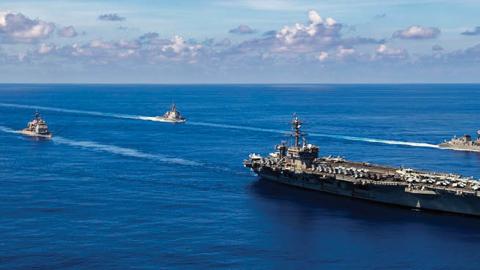Last Friday, President Biden met with his Indian, Australian, and Japanese counterparts for their Quadrilateral Security Dialogue (the “Quad” for short), a series of high-level meetings regularly held by the four countries to discuss matters of mutual security in the geographic space they all share: the Indo-Pacific region.
The 600-pound dragon in any Quad meeting — and the room on Friday — was China. Beijing’s aggressive moves in the East and South China Seas, and along the border with India, as well as mounting pressure against Taiwan, have alarmed all four powers for years. They are seen as a direct threat to everyone’s goal of “a free and open Indo-Pacific,” as the four Quad leaders asserted in their joint statement.
The Quad can have a very useful role in dealing with the China threat. For example, the navies of the four member nations — India, the United States, Japan, and Australia — now meet regularly for joint naval exercises known as the Malabar Exercises, which are important for promoting common naval strategy and interoperability in the face of Chinese provocations.
Yet neither President Biden nor India’s Narendra Modi, neither Japan’s Yoshihide Suga nor Australia’s Scott Morrison saw fit to mention China in that joint statement, or any of their public statements. Instead, the leaders talked vaguely about COVID-19, infrastructure, and climate change as areas for future Quad cooperation, even as they acknowledged the need to keep the Indo-Pacific region ‘“free from coercion” — which everyone knows means confronting China.
The responsibility for this muddle lies squarely with Washington and the Biden team. The fact is, without bold U.S. leadership, the idea of relying on Australia, India, and Japan to share the military and security burden for dealing with China as Quad allies is a formula for more confusion and worse. In other words, the idea that allied strength can make up for American weakness is a dangerous fallacy that has history working against it, and current events pointing the other way.
But here the contrast with the so-called AUKUS agreement, struck by the U.S., Australia, and the U.K. the week before, couldn’t be more obvious. The deal by which Australia will buy U.S. nuclear-powered submarines sent a clear warning to China by drawing the U.S. and Australian defense establishments closer together, and gave Britain a clear role in shaping a post-Brexit Pacific. Offending another ally, France, was the risk the administration was willing to run in order to score an Indo-Pacific strategic success.
But AUKUS also reveals the limitations of this kind of agreement if the U.S. tries to use alliances as a substitute for being a great power.
Australia is now committed to buying submarines it can never use except in conjunction with the U.S. and the U.S. Navy. And if the U.S. isn’t strong enough to confront China, then Australia will be paying tens of billions of dollars for weapons systems that add nothing to its national defense.
Japan faces the same dilemma. Tokyo recognizes it can’t deal with China without the U.S., and the promise of a strong and united Quad. But its leadership also worries whether they would be left holding the bag in a crisis in the East China Sea or over Taiwan when the U.S. has to choose between risking military
action or doing nothing.
As for India, Premier Modi certainly sees the advantages of joining with the U.S. and its Indo-Pacific allies, and not just in naval exercises. But India also has to wonder whether there is any real advantage of working with a president who just turned tail in Afghanistan and can’t protect his own border, let alone India’s.
In short, the Quad itself is in disarray without strong and forthright American leadership, including in the military arena. This is the paradox of alliances between a great power and middle or lesser powers: unless the great power already enjoys a clear military superiority over their common enemy, the lesser powers are bound to wonder if that alliance poses more of a risk to themselves than a collective benefit.
Between the two world wars France made a series of defense agreements with Poland and Czechoslovakia to contain a future resurgent Germany. The French thought the agreements would give them additional security, by getting the Poles and Czechs to do the fighting the French weren’t willing or able to do by themselves.
The Czechs and Poles, on the other hand, assumed the alliance with France meant they would never have to fight at all. When it turned out that France had no intention of risking war with Germany, they realized the joint security they had agreed to was an illusion. Each then tried to work out a separate deal with Hitler; in the end, Hitler devoured them both.
No one wants or expects that this will happen with the Quad. But perhaps in the end the real value of the Quad isn’t as a security alliance but as a forum for facilitating the sharing of advanced defense-related technologies that will give us all a future advantage over China. One promising area is hypersonics; another is AI; still another is quantum, where the four Quad nations plus South Korea can bring extensive expertise to the post-digital technology that will dominate the 21st century.
Either way, the Quad will be only as strong as its strongest member. The future of the Indo-Pacific may depend on how soon Washington wakes up to this truth.
Image Caption: The Nimitz-class aircraft carrier USS Carl Vinson (CVN 70), the Ticonderoga-class guided-missile cruiser USS Lake Champlain (CG 57), and the Arleigh Burke-class guided-missile destroyer USS Chafee (DDG 90) conduct a passing honors ceremony with the Japan Maritime Self-Defense Force (JMSDF) Murasame-class destroyer JS Ikazuchi (DD 107) and the Kongō-class guided-missile destroyer JS Chōkai (DDG 176), Sept. 19, 2021.
Read in National Review

















